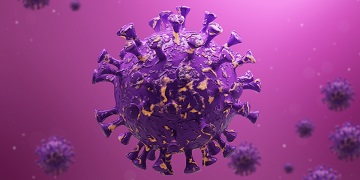BA.5 Is More Fusogenic Than BA.1 Or BA.2 And Disrupts Respiratory Epithelial And Endothelial Barriers More Efficiently And Is More Inflammatory!
Source: Medical News - BA.5 variant Aug 06, 2022 3 years, 4 months, 3 weeks, 5 days, 10 hours, 40 minutes ago
A new study involving the comparative pathogenicity of SARS-CoV-2 Omicron subvariants including 1 BA.1, BA.2, and BA.5 by Japanese researchers from Hokkaido University, The University of Tokyo, Kobe University and Kyoto University has found that the SARS-CoV-2 Ba.5 variant is more fusogenic and disrupts respiratory epithelial and endothelial barriers more efficiently and is more inflammatory!

The study team analyzed BA.5 with the other Omicron variants BA.1, BA.2, and ancestral B.1.1 comprehensively. Although in vitro growth kinetics of BA.5 is comparable among the Omicron subvariants, BA.5 become much more fusogenic than BA.1 and BA.2. The airway-on-a-chip analysis showed that the ability of BA.5 to disrupt the respiratory epithelial and endothelial barriers is enhanced among Omicron subvariants. Furthermore, in their hamster model study, in vivo replication of BA.5 is comparable with that of the other Omicrons and less than that of the ancestral B.1.1. Importantly, inflammatory response against BA.5 is strong compared with BA.1 and BA.2.
The study findings suggest that BA.5 is still low pathogenic compared to ancestral strain but evolved to induce enhanced inflammation when compared to prior Omicron subvariants.
The study findings were publsihed on a preprint server and are currently being peer reviewed.
https://www.biorxiv.org/content/10.1101/2022.08.05.502758v1
As the new subvariant BA.5 surged dramatically and displaced the BA.1 and BA.2 variants rather quickly, researchers rapidly dispatched reports showing further resistance of the SARS-CoV-2 Omicron variant against the immunity elicited by previous infections and vaccination.
https://pubmed.ncbi.nlm.nih.gov/35016196/
https://pubmed.ncbi.nlm.nih.gov/35016194/
https://pubmed.ncbi.nlm.nih.gov/35016195/
https://pubmed.ncbi.nlm.nih.gov/35016199/
https://www.biorxiv.org/content/10.1101/2021.12.17.473248v3
https://pubmed.ncbi.nlm.nih.gov/35016198/
Furthermore, morbidity of COVID-19 by infection with BA.5 is escalated, suggesting that the appropriate implementation of control measurement is urgently required.
https://www.medrxiv.org/content/10.1101/2022.07.25.22277996v1
However, comparative analysis of these Omicron subvariants, BA.1, BA.2, and BA.5 have not been well documented.
A past study showed that the clinical isolate BA.5 exhibited lower pathogenicity than the ancestral Delta in hamster models.
https://www.researchsquare.com/article/rs-1820048/v1
The c
urrent study team reported that the spike protein of BA.5 contributes the enhanced pathogenicity compared to the previous Omicron subvariant BA.2 in their hamster model.
The study team also further investigated the in vitro and in vivo characters of three clinical isolates of Omicron subvariants BA.1, BA.2, and BA.5.
Corresponding author, Dr Kei Sato, a professor at The Institute of Medical Science at The University of Tokyo told Thailand
Medical News,
“Though the virulence of the Omicron subvariants is less than that of the ancestral lineage B.1.1, the study team’s comprehensive analyses suggest that the BA.5 gains pathogenicity by evolving to enhance inflammatory response.”
Hence this might be a key factor for deterioration of mobility in human population by BA.5 infection.
https://www.medrxiv.org/content/10.1101/2022.07.25.22277996v1
Numerous past studies have using recombinant viruses have showed that fusogenicity by the viral spike protein has a great impact on viral replication and pathogenesis.
https://pubmed.ncbi.nlm.nih.gov/35568035/
https://pubmed.ncbi.nlm.nih.gov/34823256/
https://pubmed.ncbi.nlm.nih.gov/35104835/
https://pubmed.ncbi.nlm.nih.gov/34171266/
Importantly, consistent with these, the fusogenicity of the Omicron subvariants were less than the conventional B.1.1 strain and BA.5 exhibited slight high fusogenicity among Omicron subvariants.
Furthermore, in vitro growth kinetics is similar in cell lines, VeroE6/TMPRSS2, Calu-3 cells and in iPS cell-derived lung epithelial cells.
However, interestingly investigation with airway-on-a-chip in vivo environment were conducted and the resulting data showed that BA.5 has a strong barrier disruption capacity among the Omicron subvariants.
In animal studies involving hamsters, infection with BA.5 showed very strong hemorrhage and alveolar damage and supported the enhanced phenotype of BA.5 for invasion of respiratory tissues.
A past study recently showed that the Omicron subvariants including BA.5 is less pathogenic than Delta and deterioration of weight loss by BA.5 infection is slightly higher than that by BA.2 infection.
https://www.researchsquare.com/article/rs-1820048/v1
The current study findings showed that the weight loss in BA.5 infected hamsters was higher than that of other Omicron subvariant consisting with the previous study mentioned above.
In addition, by using the recombinant virus replacing spike protein gene with the BA.2 backbone, the recombinant virus bearing BA.4/5 spike protein exhibited significantly enhanced pathogenicity in hamsters in in previous studies.
In combination with this present and previous studies, the possible evolution of BA.5 spike protein to achieve higher pathogenicity shall need to be underscored.
Significantly, of these Omicron subvariants, BA.5 exhibited deterioration of weight loss and of respiratory markers. BA.5 isolate efficiently infect bronchial/bronchiolar epithelium and invade the alveolar space leading to the remaining virus replication in the lung.
As demonstrated in a previous clinical report, BA.5 exhibits higher morbidity than BA.2, suggesting inflammation influences outcoming clinical manifestations.
https://www.medrxiv.org/content/10.1101/2022.07.25.22277996v1
Hence the study team evaluated the inflammatory responses evoked by viral infection. By morphometrical analysis which is sensitive to reflect the subtle difference of inflammations, the inflammatory area of the lungs infected with BA.5 was larger than that of BA.2 and approximately equal to B.1.1. on day 5 p.i., indicating that BA.5 is more immunopathogenic than BA.2.
In mRNA levels, interferon-stimulating genes including CXCL10, ISG15, and MX-1 were upregulated upon infection.
Another past study showed the enhanced innate immune suppression by BA.4 and BA.5 compared with the previous BA.2 subvariants.
https://www.biorxiv.org/content/10.1101/2022.07.12.499603v1
The study findings show that severe inflammations of BA.5 might reflect severe clinical manifestations currently happening in human population.
In summary, the study findings using clinically isolated Omicron subvariants, BA.1, BA.2, and BA.5 by in vitro experiments and the established animal models contributed to improved understanding of SARS-CoV-2 ecology and evolution.
The study findings suggest that the characterization described herein should be offered as an aid in implementing control measurements on COVID-19.
For more on the
BA.5 variant, keep on logging to Thailand
Medical News.
